7.1.5: Using Equations to Solve for Unknown Angles
- Page ID
- 38723
\( \newcommand{\vecs}[1]{\overset { \scriptstyle \rightharpoonup} {\mathbf{#1}} } \)
\( \newcommand{\vecd}[1]{\overset{-\!-\!\rightharpoonup}{\vphantom{a}\smash {#1}}} \)
\( \newcommand{\id}{\mathrm{id}}\) \( \newcommand{\Span}{\mathrm{span}}\)
( \newcommand{\kernel}{\mathrm{null}\,}\) \( \newcommand{\range}{\mathrm{range}\,}\)
\( \newcommand{\RealPart}{\mathrm{Re}}\) \( \newcommand{\ImaginaryPart}{\mathrm{Im}}\)
\( \newcommand{\Argument}{\mathrm{Arg}}\) \( \newcommand{\norm}[1]{\| #1 \|}\)
\( \newcommand{\inner}[2]{\langle #1, #2 \rangle}\)
\( \newcommand{\Span}{\mathrm{span}}\)
\( \newcommand{\id}{\mathrm{id}}\)
\( \newcommand{\Span}{\mathrm{span}}\)
\( \newcommand{\kernel}{\mathrm{null}\,}\)
\( \newcommand{\range}{\mathrm{range}\,}\)
\( \newcommand{\RealPart}{\mathrm{Re}}\)
\( \newcommand{\ImaginaryPart}{\mathrm{Im}}\)
\( \newcommand{\Argument}{\mathrm{Arg}}\)
\( \newcommand{\norm}[1]{\| #1 \|}\)
\( \newcommand{\inner}[2]{\langle #1, #2 \rangle}\)
\( \newcommand{\Span}{\mathrm{span}}\) \( \newcommand{\AA}{\unicode[.8,0]{x212B}}\)
\( \newcommand{\vectorA}[1]{\vec{#1}} % arrow\)
\( \newcommand{\vectorAt}[1]{\vec{\text{#1}}} % arrow\)
\( \newcommand{\vectorB}[1]{\overset { \scriptstyle \rightharpoonup} {\mathbf{#1}} } \)
\( \newcommand{\vectorC}[1]{\textbf{#1}} \)
\( \newcommand{\vectorD}[1]{\overrightarrow{#1}} \)
\( \newcommand{\vectorDt}[1]{\overrightarrow{\text{#1}}} \)
\( \newcommand{\vectE}[1]{\overset{-\!-\!\rightharpoonup}{\vphantom{a}\smash{\mathbf {#1}}}} \)
\( \newcommand{\vecs}[1]{\overset { \scriptstyle \rightharpoonup} {\mathbf{#1}} } \)
\( \newcommand{\vecd}[1]{\overset{-\!-\!\rightharpoonup}{\vphantom{a}\smash {#1}}} \)
Lesson
Let's figure out missing angles using equations.
Exercise \(\PageIndex{1}\): Is this Enough?
Tyler thinks that this figure has enough information to figure out the values of \(a\) and \(b\).
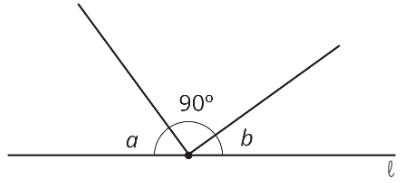
Do you agree? Explain your reasoning.
Exercise \(\PageIndex{2}\): What Does It Look Like?
Elena and Diego each wrote equations to represent these diagrams. For each diagram, decide which equation you agree with, and solve it. You can assume that angles that look like right angles are indeed right angles.
1. Elena: \(x=35\)
Diego: \(x+35=180\)

2. Elena: \(35+w+41=180\)
Diego: \(w+35=180\)

3. Elena: \(w+35=90\)
Diego: \(2w+35=90\)

4. Elena: \(2w+35=90\)
Diego: \(w+35=90\)

5. Elena: \(w+148=180\)
Diego: \(x+90=148\)

Exercise \(\PageIndex{3}\): Calculate the Measure
Find the unknown angle measures. Show your thinking. Organize it so it can be followed by others.


Lines \(l\) and \(m\) are perpendicular.


Are you ready for more?
The diagram contains three squares. Three additional segments have been drawn that connect corners of the squares. We want to find the exact value of \(a+b+c\).

- Use a protractor to measure the three angles. Use your measurements to conjecture about the value of \(a+b+c\).
- Find the exact value of \(a+b+c\) by reasoning about the diagram.
Summary
To find an unknown angle measure, sometimes it is helpful to write and solve an equation that represents the situation. For example, suppose we want to know the value of \(x\) in this diagram.

Using what we know about vertical angles, we can write the equation \(3x+90=144\) to represent this situation. Then we can solve the equation.
\(\begin{aligned} 3x+90&=144 \\ 3x+90-90&=144-90 \\ 3x&=54 \\ 3x\cdot\frac{1}{3}&=54\cdot\frac{1}{3} \\ x&=18\end{aligned}\)
Glossary Entries
Definition: Adjacent Angles
Adjacent angles share a side and a vertex.
In this diagram, angle \(ABC\) is adjacent to angle \(DBC\).
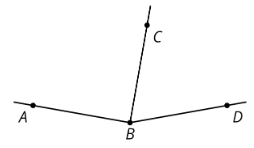
Definition: Complementary
Complementary angles have measures that add up to 90 degrees.
For example, a \(15^{\circ}\) angle and a \(75^{\circ}\) angle are complementary.
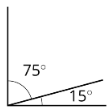

Definition: Right Angle
A right angle is half of a straight angle. It measures 90 degrees.
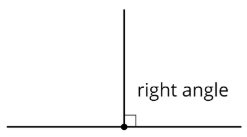
Definition: Straight Angle
A straight angle is an angle that forms a straight line. It measures 180 degrees.

Definition: Supplementary
Supplementary angles have measures that add up to 180 degrees.
For example, a \(15^{\circ}\) angle and a \(165^{\circ}\) angle are supplementary.


Definition: Vertical Angles
Vertical angles are opposite angles that share the same vertex. They are formed by a pair of intersecting lines. Their angle measures are equal.
For example, angles \(AEC\) and \(DEB\) are vertical angles. If angle \(AEC\) measures \(120^{\circ}\), then angle \(DEB\) must also measure \(120^{\circ}\).
Angles \(AED\) and \(BEC\) are another pair of vertical angles.
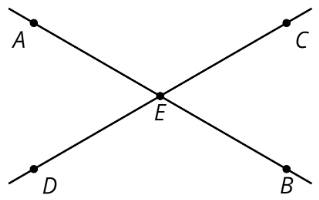
Practice
Exercise \(\PageIndex{4}\)
Segments \(AB\), \(DC\), and \(EC\) intersect at point \(C\). Angle \(DCE\) measures \(148^{\circ}\). Find the value of \(x\).

Exercise \(\PageIndex{5}\)
Line \(l\) is perpendicular to line \(m\). Find the value of \(x\) and \(w\).

Exercise \(\PageIndex{6}\)
If you knew that two angles were complementary and were given the measure of one of those angles, would you be able to find the measure of the other angle? Explain your reasoning.
Exercise \(\PageIndex{7}\)
For each inequality, decide whether the solution is represented by \(x<4.5\) or \(x>4.5\).
- \(-24>-6(x-0.5)\)
- \(-8x+6>-30\)
- \(-2(x+3.2)<-15.4\)
(From Unit 6.3.3)
Exercise \(\PageIndex{8}\)
A runner ran \(\frac{2}{3}\) of a 5 kilometer race in 21 minutes. They ran the entire race at a constant speed.
- How long did it take to run the entire race?
- How many minutes did it take to run 1 kilometer?
(From Unit 4.1.2)
Exercise \(\PageIndex{9}\)
Jada, Elena, and Lin walked a total of 37 miles last week. Jada walked 4 more miles than Elena, and Lin walked 2 more miles than Jada. The diagram represents this situation:

Find the number of miles that they each walked. Explain or show your reasoning.
(From Unit 6.2.6)
Exercise \(\PageIndex{10}\)
Select all the expressions that are equivalent to \(-36x+54y-90\).
- \(-9(4x-6y-10)\)
- \(-18(2x-3y+5)\)
- \(-6(6x+9y-15)\)
- \(18(-2x+3y-5)\)
- \(-2(18x-27y+45)\)
- \(2(-18x+54y-90)\)
(From Unit 6.4.2)


